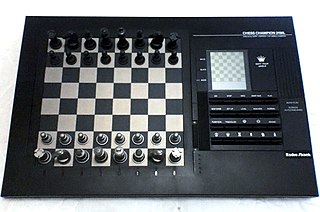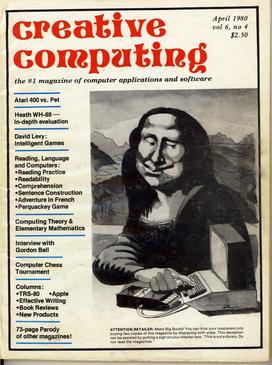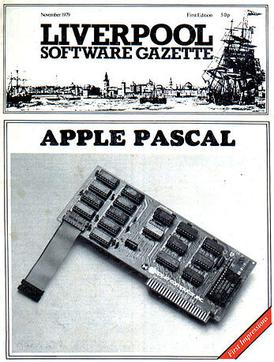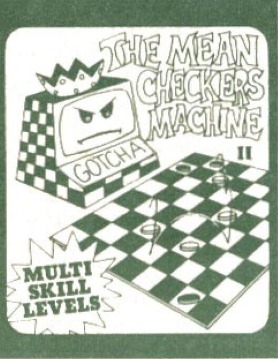
The Apple II is a personal computer released by Apple Inc. in June 1977. It was one of the first successful mass-produced microcomputer products and is widely regarded as one of the most important personal computers of all time due to its role in popularizing home computing and influencing later software development.

The Intel 8080 ("eighty-eighty") is the second 8-bit microprocessor designed and manufactured by Intel. It first appeared in April 1974 and is an extended and enhanced variant of the earlier 8008 design, although without binary compatibility. Although earlier microprocessors were commonly used in mass-produced devices such as calculators, cash registers, computer terminals, industrial robots, and other applications, the 8080 saw greater success in a wider set of applications, and is largely credited with starting the microcomputer industry.

The TRS-80 Micro Computer System is a desktop microcomputer developed by American company Tandy Corporation and was sold through their Radio Shack stores. Launched in 1977, it is one of the earliest mass-produced and mass-marketed retail home computers. The name is an abbreviation of Tandy Radio Shack, Z80 [microprocessor], referring to its Zilog Z80 8-bit microprocessor.

VisiCalc is the first spreadsheet computer program for personal computers, originally released for the Apple II by VisiCorp on October 17, 1979. It is considered the killer application for the Apple II, turning the microcomputer from a hobby for computer enthusiasts into a serious business tool, and then prompting IBM to introduce the IBM PC two years later. More than 700,000 copies were sold in six years, and up to 1 million copies over its history.

The Zilog Z80 is an 8-bit microprocessor designed by Zilog that played an important role in the evolution of early computing. Launched in 1976 and software-compatible with the Intel 8080, it offered a compelling alternative due to its better integration and increased performance. As well as the 8080's seven registers and flags register, the Z80 had an alternate register set that duplicated them, two 16-bit index registers and additional instructions including bit manipulation and block copy/search.

Computer chess includes both hardware and software capable of playing chess. Computer chess provides opportunities for players to practice even in the absence of human opponents, and also provides opportunities for analysis, entertainment and training. Computer chess applications that play at the level of a chess grandmaster or higher are available on hardware from supercomputers to smart phones. Standalone chess-playing machines are also available. Stockfish, Leela Chess Zero, GNU Chess, Fruit, and other free open source applications are available for various platforms.

Creative Computing was one of the earliest magazines covering the microcomputer revolution. Published from October 1974 until December 1985, the magazine covered the spectrum of hobbyist/home/personal computing in a more accessible format than the rather technically oriented Byte.
Electric Pencil, released in December 1976 by Michael Shrayer, was the first word processor program for home computers.

Microchess, sometimes written as MicroChess, is a chess program developed for the MOS Technology KIM-1 microcomputer by Peter R. Jennings in 1976, and published by his company Micro-Ware. The game plays chess against the human player at a beginner level, with the player entering moves via a keyboard and the computer responding, both in a custom chess notation. The game was ported to many other microcomputers such as the TRS-80, Apple II, Commodore PET, and Atari 8-bit computers by Micro-Ware and its successor company Personal Software between 1976 and 1980, with later versions featuring graphics and more levels of play. A dedicated hardware version of the game called ChessMate was produced by Commodore International in 1978, and the game's engine was licensed to Novag for its dedicated Chess Champion Mk II chess computer in 1979.
Chess was a pioneering chess program from the 1970s, written by Larry Atkin, David Slate and Keith Gorlen at Northwestern University. Chess ran on Control Data Corporation's line of supercomputers. Work on the program began in 1968 while the authors were graduate students at the university. The first competitive version was Chess 2.0 which gradually evolved to Chess 3.6 and was rewritten as the 4.x series. It dominated the first computer chess tournaments, such as the World Computer Chess Championship and ACM's North American Computer Chess Championship. At the ACM event, Chess won eight of the ten tournaments held from 1970 to 1979. NWU Chess adopted several innovative or neglected techniques including bitboard data structures, iterative deepening, transposition tables, and an early form of forward pruning later called futility pruning. The 4.x versions were the first programs to abandon selective search in favor of full-width fixed-depth searching.

Liverpool Software Gazette was a short-lived computer magazine published by Microdigital Ltd, a company who were based in Liverpool, England and run by Bruce Everiss.

The 1978 World Chess Championship was played between Anatoly Karpov and Viktor Korchnoi in Baguio, Philippines, from July 18 to October 18, 1978. Karpov won, thereby retaining the title.

Sargon III is a computer chess program. It is a sequel to Sargon II.
Peter R. Jennings is a British-Canadian physicist, scientist, inventor, software developer, computer chess programmer, and entrepreneur. He is most notable for creating MicroChess, the first microcomputer game to be sold commercially.

The Mean Checkers Machine is a 1980 video game designed by Lance Micklaus for The Software Exchange for the TRS-80 Level II Model I microcomputer.

Sargon II is a sequel to Sargon. Both are computer chess programs for home computers.
The 17th season of the Top Chess Engine Championship began on 2 January 2020 and ended on 22 April 2020. TCEC Season 16 3rd-place finisher Leela Chess Zero won the championship, defeating the defending champion Stockfish 52.5-47.5 in the superfinal.
The 19th season of the Top Chess Engine Championship began on 6 August 2020 and ended on 16 October 2020. The season 19 superfinal was a rematch between Stockfish and Leela Chess Zero, the same two engines that had contested the superfinal in the previous two seasons. Stockfish, the defending champion, won by 9 games.
The 20th season of the Top Chess Engine Championship began on 1 December 2020 and ended on 1 February 2021. The defending champion was Stockfish, which defeated Leela Chess Zero in the previous season's superfinal. The season 20 superfinal was a rematch between the same two engines. Stockfish once again came out ahead, winning by 6 games.
















